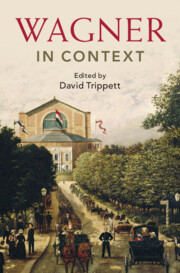Book contents
- Wagner in Context
- Composers in Context
- Wagner in Context
- Copyright page
- Contents
- Illustrations
- Musical Examples
- Contributors
- Acknowledgements
- Abbreviations
- Introduction
- I Place
- II People
- III Politics, Ideas, and Bodies
- IV Life, Language, and the Ancient World
- V Music and Performance
- Chapter 29 Orchestration
- Chapter 30 Wagner and Analysis: Siegfried and the Rheinmaidens
- Chapter 31 The Scene of Grand Opera
- Chapter 32 Wagner on the Move
- Chapter 33 Stage Technology
- Chapter 34 Historic Stagings: 1876–1976
- VI Reception
- Further Reading
- Select Bibliography
- Index
Chapter 29 - Orchestration
from V - Music and Performance
Published online by Cambridge University Press: 14 March 2024
- Wagner in Context
- Composers in Context
- Wagner in Context
- Copyright page
- Contents
- Illustrations
- Musical Examples
- Contributors
- Acknowledgements
- Abbreviations
- Introduction
- I Place
- II People
- III Politics, Ideas, and Bodies
- IV Life, Language, and the Ancient World
- V Music and Performance
- Chapter 29 Orchestration
- Chapter 30 Wagner and Analysis: Siegfried and the Rheinmaidens
- Chapter 31 The Scene of Grand Opera
- Chapter 32 Wagner on the Move
- Chapter 33 Stage Technology
- Chapter 34 Historic Stagings: 1876–1976
- VI Reception
- Further Reading
- Select Bibliography
- Index
Summary
Whilst Richard Wagner has long been acknowledged as one of the central figures in the history of orchestration, his treatment of the orchestra has only rarely received scholarly attention. This chapter uses a series of analytical vignettes to examine Wagner’s approach to the orchestra, each addressing a paradox or opposition. The aim is not to expound some grand, overarching narrative, but, instead, to use the friction between competing factors to demonstrate the inherent complexity of Wagner’s approach to the orchestra. The multidimensionality of Wagner’s orchestration is also seen in the highly nuanced interaction of its three main parameters: texture, timbre, and spatiality. The development of Wagner’s orchestration over his lifetime is not presented as a continuous progression; the individuality of each of Wagner’s scores – and even of scenes within those operas – reflects the inseparability of Wagner’s orchestration from its dramatic motivation.
- Type
- Chapter
- Information
- Wagner in Context , pp. 287 - 299Publisher: Cambridge University PressPrint publication year: 2024

